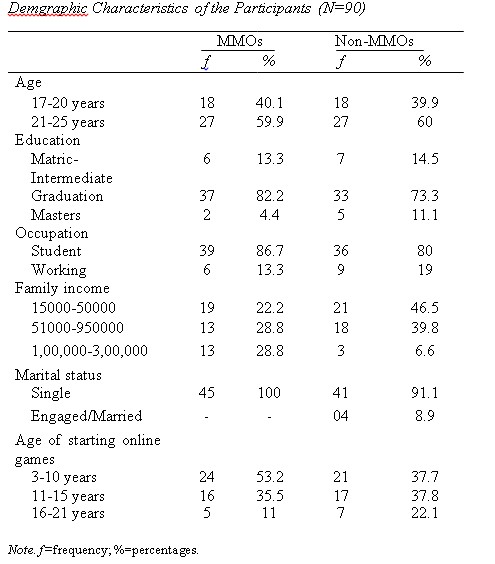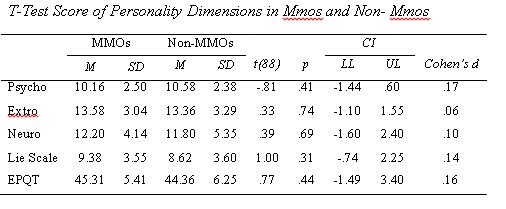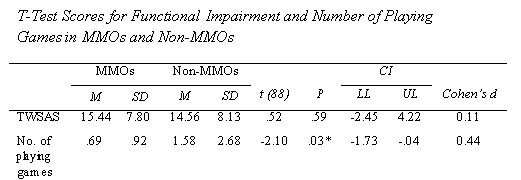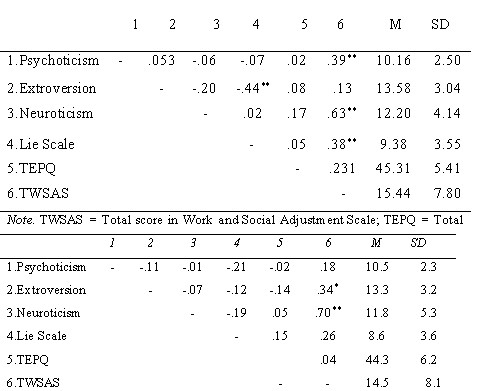Personality Dimensions & Functional Impairment in Massively Multiplayer Online Players (MMOs’) and Non Massively Multiplayer Online Players (Non-MMO’s)
Verda Zahid
Centre for Clinical Psychology, University of the Punjab, Lahore
*Tehreem Arshad
Centre for Clinical Psychology, University of the Punjab, Lahore
The present study was conducted to investigate various dimensions of personality and functional impairment in Massively Multiplayer Online Players and Non Massively Multiplayer Online Players. For this purpose a between group, research design was employed. A sample of 90 participants (45 MMO‟s and 45 Non-MMO‟s) was collected from various gaming zones in Lahore. Young‟s (1998) Diagnostic Questionnaire for Internet addiction was used as a screening tool. Eysenck Personality Inventory (EPI; Eysenck & Eysenck, 1975) was administered to assess personality dimension; and Work and Social Adjustment Scale (Mataix-Col et al., 2005) was used to assess functional impairment. Results depicted no difference in personality dimensions and functional impairment in MMOs and non- MMOs. Significant difference was found in number of playing games in MMOs and Non- MMOs. MMOs play less number of games as compared to Non-MMOs. No significant relationship was found in personality dimensions and functional impairment in non-MMOs. Moreover, negative relationship between extraversion and lie scale (sub-scale of Eysenck Personality Inventory) reveals that an extrovert participant would score less on lie scale.
Keywords: personality dimensions, functional impairment, mmo players, non-mmo players
With the current flow of dynamic information, internet has created a global village where information can be shared and communication can be done easily. It is an essential communicative as
* Correspondance concerning this article should be addressed to Tehreem Arshad, Assistant Professor, Centre for Clinical Psychology, University of the Punjab, Lahore. Email: tehreem.ccpsy@pu.edu.pk well as informative tool, a medium which can connect us to the outer world. Internet has many advantages; but disadvantages as well such as weakening real-world ties. Moreover, people use internet for various reasons such as entertainment and socialization (Harbaugh, 2010).
Researchers working on Pathological Internet Users (PIU) have received little attention composed to progressively more common and exciting practice of online interpersonal performance playing massively multiplayer online (MMO) games. Martin (2008) reported that the impact of online interactive gaming in the habits of pathological internet users is still unknown. MMOs are a quickly rising part of internet activity with over 47 million subscriptions (Chan, Vorderer, & White 2006). People playing MMO games may come in contact with other players and have interpersonal interactions (Cole & Griffiths, 2007; Lo, Wang, & Fang, 2005; Taylor, 2006; Yee, 2007). The awareness and understanding of MMO‟s is limited for this purpose, the present study was planned to assess differences in personality dimensions and functional impairment in online players.
Massive Multiplayer Online Gamers/Players (MMOs) refers to an electronic game, in which many computers are connected to a central server and players play the game on these computers. The users interact with each other with fake identities or graphical representation. However, Non-Massively Multiplayer Online Players/ Single Player (Non-MMOs‟) is defined as voluntary activity or occupation executed within certain fixed limits of time and place, according to rules freely accepted but absolutely binding, having its aim in itself and accompanied by a feeling of tension, joy, and the consciousness that it is different from ordinary life (Huizinga, 1968).
Personality refers to enduring and organized patterns or traits which are psychological in nature and influence the individual‟s interaction and adaptation to, the intra psychic and physical as well as social environment (Larsen & Buss, 2005). Eysenck (1967) proposed a model of personality. He determined three personality dimensions: extraversion, neuroticism and psychoticism. Extraversion includes traits like social, active, and love to have new interactions. Gray (1981) explained the biological mechanism of extrovert and neuroticism as a difference in reaction to rewards and punishment. Extroverts give more attention towards rewards. While neurotics are sensitive to punishment. The second personality dimension in Eysenck‟s model of personality is Neuroticism which is defined as emotional sensitivity or reaction to more negative emotions whereas stability deals with a more balanced temper and emotional consistency. Eysenck viewed neurotic trait as highly sensitive to emotional experiences. The individuals with high neurotic traits may reduce their negative emotions by indulging in maladaptive behavior like addiction. Psychoticism refers to having a psychological problem/ illness. This trait increases the tendency of mental illness and deviant behavior such as antisocial, hostile, non-empathetic and manipulative (Cherry, 2013).
Functional impairment is a term used to describe limitations in the social and occupational spheres of life. Social areas entail interpersonal interactions and relationships where as occupational areas entail work and employment. Moreover, functional impairment is used as a criterion which has to be fulfilled in order to make a diagnosis (Ustun & Kennedy, 2009).
Internet addiction may result from a need for social interaction and perceptibility (Amichai- Hamburger, Wainapel, & Fox, 2002; Weiser, 2001). As compared to physical interaction, internet provides the opportunity for ambiguity and control during communication (Kandell, 1998). Internet minimizes the risk during interaction and helps in attaining the roles or characteristics that might not be a part of human face to face interaction (Amichai- Hamburger, Wainapel, & Fox, 2002; Peris et al., 2002; Sanders, Field, Diego, & Kaplan, 2000; Scealy, Phillips, & Stevenson, 2002). Some studies revealed that online gaming may serves as a source of expressing oneself in ways that seem to be uncomfortable in real interactions. MMOs propose a platform where cooperation, inspiration, support and entertainment can be practiced (Papacharissi & Rubin, 2000; Brian & Peter, 2004).
Nithya and Julius (2007) assessed the impact of personality traits and self-concept on internet usage in India. On the basis of the number of hours spent online, the users were categorized as heavy and light users. There was no significant difference of personality traits in the heavy and light user. However it was found that heavy users had a high self-esteem.
Hameed, Nisa, Zehra, and Nishat (2013) conducted an exploratory study about internet addiction and satisfaction with life in students. The sample comprised of 334 regular enrolled students from different institutes of Karachi. Internet use was screened out with the criteria of spending one hour per day for at least six months. Assessment measures were Internet Addiction Test (Young, 1998) and Satisfaction with Life Scale as significant difference was found regarding satisfaction with life for and mild, moderate and severe internet users.
The present research aimed to study personality dimensions and functional impairment in Massively Multiplayer Online Players (MMOs) and non-MMOs. Excessive use of internet leads to pathological usage which can contribute to individuals becoming an MMO and may cause problems in social leisure activities, relationships, home management and the ability to work. There are many factors in the personality who play important role as a mediator in developing MMO‟s existence. Worth and Book (2014) concluded that people with high psychological adjustment, and personality traits (extroversion and openness), motivation and goal orientation are more prone to become MMO‟s.
RationaleThe study will be helpful in understanding problematic internet use by exploring the contribution of MMOs in internet use. This information will be helpful for counseling professionals. The study will further investigate the ratio of problematic internet use in MMOs users, social contributors and the extent to which these individuals seek treatment. The research will also add to the understanding of problematic internet use for counseling professional by extending research beyond common university population to a wider range of MMOs players.
Objectives of the Study- To explore the difference in personality dimensions in MMOs and non-MMOs.
- To explore the difference in functional impairment in MMOs and non-MMOs.
- To explore the difference in number of playing games for MMOs and non-MMOs.
- To explore the relationship between personality dimensions and functional impairment in MMOs.
- To explore the relationship between personality dimensions and functional impairment in non-MMOs.
- There is likely to be a difference in personality dimensions in MMOs and non-MMOs.
- There is likely to be a difference in functional impairment in MMOs and non-MMOs.
- There is likely to be a difference in the number of playing games for MMOs and non-MMOs.
- There is likely to be a relationship between personality dimensions and functional impairment in MMOs.
- There is likely to be a relationship between personality dimensions and functional impairment in non-MMOs.
Method
Research DesignThe present study was conducted with the help of group research design. It was used to find out difference between personality dimensions and functional impairment in Massively Multiplayer Online Players (MMO‟s) and Non Massively Multiplayer Online Players (Non-MMO‟s).
Research SampleNon-probability purposive sampling technique was used to collect data from gaming spots, located in upper areas of Lahore. The research sample consisted of total 90 participants (45 MMO‟s and 45 Non- MMOs‟) with age range of 17–25 years. Initially, 170 participants took part in the research. 100 were qualified and screened out as internet addicted. 70 participants were rejected because they were not internet addicts and did not score five on eight questions of Young‟s Diagnostic Questionnaire (didn‟t fulfill the criteria of research study). Among 100 participants, 10 more were also disqualified because of incomplete information. Thus, final sample was comprised of 90 participants. By comparing both groups majority of the participants were ranging between the ages of 21 to 25. The detailed demographic information is provided in table 1.
Table 1 
Demographic questionnaire. In the present study demographic questionnaire was used which depicted details such as, age, gender, education, marital status, occupation, city/town of residence, place of internet access and online gaming was also assessed.
Eysenck Personality Inventory ([EPI]; Eysenck & Eysenck, 1975). It measures three personality dimensions in adults namely; extraversion, neuroticism and psychoticism. It is a 48-items measure with four domains (Extraversion, Neuroticism, Psychoticism and the Lie Scale) with each containing 12 items. The permission to use and translate the scale was taken from the author. The Cronbach alpha coefficient for men and women respectively of neuroticism are 0.84 and 0.80; extraversion, 0.88 and 0.84; psychoticism, 0.62 and 0.61; and lie scale, 0.77 and 0.73 (EPQ; Francis, Brown, & Philipchalk, 1992). In the present study EPQ Urdu translated version by Amjad and Kausar (2003) was used.
Work and Social Adjustment Scale ([WSAS]; Mataix-Col, Rosario-Campos, & Leckman, 2005). This measure was used to screen out impaired functioning . It measures work/social and other adjustment (Mataix-Col, Rosario-Campos, & Leckman, 2005). It is a 5-item measure. The range of internal consistency is 0.70 to 0.94 and test-retest reliability is 0.73. The correlation of WSAS for depression was 0.76 and for OCD it was found to be 0.61(Mundt, Marks, Shear, & Greist, 2002). The Cronbach alpha for the present study is α = .67. In present study the questionnaire was translated in to Urdu after permission of the author.
Young’s Diagnostic Questionnaire ([YDQ]; Young, 1998). The measure was devised on DSM-IV criteria for pathological gambling. The 8 item scale (Young, 1998; Johansson & Gotestam, 2004) was modified to Internet Addiction Scale. It is used to assess the impact of internet on the user‟s life. The construct validity is yet to be explored. Participant reported five out of eight “Yes” to the questions that would screened out participant an internet addict. In the current study permission from the author was taken in order to translate and use in study.
ProcedureFirst of all permission and approval to conduct the study was taken from the Centre for Clinical Psychology and the department authorized the research to be conducted. Then, the permissions for using the measures were taken from the authors. A pilot study was conducted on ten participants (5 MMOs and 5 non-MMOs). It was carried out to determine the practicality, comprehension sequence as well as estimated time required for administration of study measures.
The main study was carried out and permissions from various gaming spots and institutes were acquired. For MMOs data collection gaming zones were located on Link Road, Barkat Market, Samnabad, Defence Housing Authority etc. For non-MMOs data collection local community members were also approached from different institutes. The participants were briefed about the purpose of the study. First of all screening was done, after screening, the set of questionnaires comprising on Demographic information, Work and Social Adjustment Scale, Functional Impairment and Eysenck Personality Questionnaire were administered. Ethical consideration of the study was fully ensured.
Results
Table 2 shows that there are no differences in personality dimensions in MMOs and Non-MMOs, however there are differences in the mean scores of Neuroticism, Lie Scale and total score of Eysenck Personality Questionnaire.
Table 2 
Note. MMOs = Multi Massive Online Players; Non-MMOs = Non-Multi Massive Online Players; Psycho = Psychoticism; Extro = Extroversion; Neuro = Neuroticism; EPQT = Total score of Eysenck Personality Questionnaire; CI= Confidence Interval.
Table 3 shows that there are no differences in functional impairment in MMOs and Non-MMOs, however table shows differences in mean scores of functional impairment in MMOs and Non-MMOs. It also depicts that there are significant differences in the number of playing games in MMOs and Non-MMOs. MMOs play less number of games as compared to Non-MMOs.
Table 3 
Note. TWSAS = Total score of work social adjustment scale; MMOs = Multi Massive Online Players; Non-MMOs = Non-Multi Massive Online Players; CI = Confidence interval. *p < 0.05.
Table 4 shows no significant relationship between personality dimensions and functional impairment. Findings show that there is a negative relationship between Extroversion and Lie scale that reveals an extrovert participant would score less on the Lie Scale.
Table 4 
Note. TWSAS = Total score in Work and Social Adjustment Scale; TEPQ = Total
Score of Eysenck‟s Personality Questionnaire. **p < 0.001.
Table 5Table 5 shows no significant relationship in personality dimensions and functional impairment in non-MMOs.
Pearson Product Moment Correlation Showing the Correlations of Personality Dimensions and Functional Impairment In Non-MMOS
Note. TWSAS = Total score in Work and Social Adjustment Scale; TEPQ = Total Score of Eysenck‟s Personality Questionnaire; M = mean; SD = standard deviation. **p < 0.001.
Discussion
The present study explored the differences between functional impairment and personality dimensions in MMOs and non-MMOs with internet addiction.
Demographic characteristics showed that there was a sample of 45 MMOs and 45 non-MMOs. The age range of the sample was 17-25 years. Several gaming zones of Lahore were selected for data collection of MMO players whereas different institutes were located for data collection of non-MMOs/ Single Players. Majority of the participants ranged between the ages of 21 to 25. In the category of education, three quarter of the sample lay in the category of graduation. Most of the participants were unemployed or students. The monthly income of research participants was within the range of 53000-95000. Most of the participants reported nuclear family system.
One of the hypotheses of the study was that there would be a difference in personality dimensions in MMOs and non-MMOs. However, results showed no significant differences. Collins, Freeman, and Chamarro-Premuzic (2012) found contradictory findings by exploring the relationship between personality traits and both normal and massively multiplayer online role playing game (MMORPGs). Papacharissi and Rubin (2000) highlighted that people who have less socialization in real world use inter net instead of socialization whereas the internet serves as a source of information for extroverts. They are more interested in face to face social interactions. The current study did not support the findings of these researches. It might happen because participants of the current study were reported as free gamers. If the gamers would be Crude gamers the result would have been different.
Another hypothesis of the current study was that there would be a difference in functional impairment in MMOs and non-MMOs. Shen, Ng, and Tan (2016) reported that when people start to abuse something, the pleasure gained from it and handiness make the person addicted to it. The increasing trends of Massively-Multiplayer Online Role-Playing Games (MMORPGs) in adolescents and young adults result in behavioral problems, academic issues, and social withdrawal.
The current study showed contradictory findings, it is because excessive online gaming players were not taken. Participants were players who do not play more than 10 hours.
Results of the present research showed no significant difference in functional impairment in MMOs and non-MMOs. Addiction depicting that online gaming does not lead to functional impairment. Yand and Tung (2007) reported that although the internet addicts perceived that excessive internet usage was affecting their routine, academic performance and relationships with teachers and families negatively, but they also considered internet use as a source of enhancing peer relationships.
The third hypothesis of the study was that there is likely to be a difference in number of playing games in MMOs and non-MMOs. Results depicted that the number of players started playing games at the age range of 3 to 10 years of both groups. It reflects that MMO users may prefer to spend more time in their games and perceive socialization through gaming than the social relationships. MMO users have different beliefs about social life due to which they could be perceived as introverts or anti-social by others. These results reveal many factors that did not support study hypothesis. Difference in number of playing games indicates that MMOs play few numbers of games for longer duration whereas non MMOs/Single player play a variety of games for many hours.
The fourth hypothesis of the current study was to explore the relationship between personality dimensions and functional impairment in MMOs. The results showed contradictory findings to literature researches. Tosun and Lajunen (2009) found that psychoticism was related to internet only friends and establishing new relationships whereas extroversion was the only personality variable found to be related to maintaining long distance and daily relationships. Results indicated a negative relationship between extroversion and lie scale. Kenny, Albright, Malloy, and Kashy (1994) explored lie-telling in everyday life. The participants kept a diary for a week and recorded the lies they told during socialization. The results of the study were similar to the hypothesis of this study. It was found that people, who were manipulative, concerned with self-presentation and social told more lie and their lies were more self-serving. People with fewer lies were found to be highly socialized and high quality of same-sex relationships however their lies were found to be more other- oriented.
The last hypothesis of the study was that there would be a relationship between personality dimensions and functional impairment in non-MMOs. Pearson correlation results showed no significant relationship between personality dimensions and functional impairment in non-MMOs.
Conclusion
The results did not reveal significant findings. There are no differences in personality dimensions in MMOs and Non-MMOs; however there are differences in the mean scores of Neuroticism, Lie Scale and total score of Eysenck Personality Questionnaire
There are no differences in functional impairment in MMOs and Non-MMOs; however differences become evident on mean scores of functional impairment in MMOs and Non-MMOs. There is difference in the number of playing games in MMOs and non-MMOs. It depicts that MMO users are prone to devote much time games and consider socialization by their games than the social life of the real world. It can be suggested that MMO have different beliefs about social life due to which they could be perceived as introvert or anti- social by others.
Limitations and SuggestionsOne of the limitations of study was limited time. It was difficult to get appropriate attention and time in gaming zones. Thus more time was needed for data collection and should be taken into consideration for future studies. Crude players (who spend more than 8 hours a day in gaming), another type could be included in future studies. Psychological wellbeing, motives and interest of online players also need to be explored.
ImplicationsInternet addiction is an important social issue to be catered. Social, emotional and functional impairments are the result of compulsive online gaming. Seminars and workshops in educational institutes are needed to raise awareness in students regarding the effect of compulsive online gaming on attention, memory, other cognitive functions reaching to poor academic performance. Recommendations should be implemented in curriculum policy to include extracurricular, sport activities to engage students in healthy and productive channels of physical and mental energy.
References
Amjad, N. & Kausar, R. (2003). Personality Differences in University Science and Arts students. Conference on Positive Psychology, Government College University, Lahore, January 25, 2003.
Chan, E. & Vorderer, P. (2006). Massively multiplayer online games. New Jersey, USA: Lawrence Erlbaum Associates Publishers
Cherry, K. (2013). Social learning theory. Retrieved January, 10, 2013.
Cole, H. & Griffiths, M. (2007). Social interactions in massively multiplayer online role-playing games. Cyber Psychology and Behavior, 10(4), 575–583.
Collins, E., Freeman, J., &Chamarro-Premuzic, T. (2012). Personality traits associated with problematic and non-problematic massively multiplayer online role playing game use. Personality and Individual Differences, 52(2), 133-138.
Eysenck H. J. & Eysenck S. G. B. (1975). Manual of the Eysenck Personality Questionnaire. Hodder and Stoughton, London.
Eysenck H. J. (1967). The Biological Basis of Personality. C. C. Thomas, U.S.A.
Francis, L. J., Brown, L. B., & Philipchalk, R. (1992). The development of an abbreviated form of the Revised Eysenck Personality Questionnaire (EPQR-A): Its use in students in England, Canada, the USA and Australia.Personality and Individual Differences, 13(4), 443-449.
Gray, J. A. (1981). A critique of Eysenck‟s theory of personality. A Model for Personality, 246-276. Springer Berlin Heidelberg.
Hameed, S., Nisa, M., Zehra, S., & Nishat, A. (2013).study of perceived social support as related to distress in Type-II diabetes patients. Social Science International, 29(1), 51.
Hamburger, A. Y., Wainapel, G., & Fox, S. (2002). On the internet no one knows I‟m an introvert: Extroversion, neuroticism, and internet interaction. Cyber Psychology & Behavior, 5, 125– 128.
Harbaugh, R. E. (2010).The Effect of Personality Styles (Level of Introversion- Extroversion) on Social Media Use. The Elon Journal of Undergraduate Research in Communications, 1(2), 70-86.